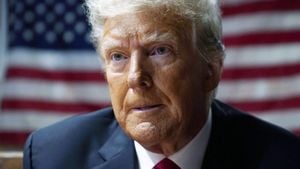The rising tensions between the United States and China continue to capture global attention, particularly as economic concerns surface from various fronts. Recent developments indicate possible repercussions on both sides, particularly concerning trade policies and military actions.
The U.S. has ramped up efforts to curb investments directed toward China and other regions perceived as adversaries. This regulatory approach primarily focuses on advanced technology sectors, including semiconductors, microelectronics, and artificial intelligence.
For organizations like the Korea Chamber of Commerce and Industry (KCCI), the proposed rules are particularly alarming. Their letter to the U.S. Treasury, marked as the first official response from Korea, questions the clarity of regulations affecting Korean companies investing within China.
The KCCI urged for explicit definitions within the proposal—uncertainties around penalties faced by non-American firms, particularly under specific scenarios, raised red flags for many stakeholders. They emphasized the potential prejudice against Korean firms, underscoring worries surrounding their ability to invest unhindered.
Meanwhile, the geopolitical backdrop continues to evolve dramatically. Reports from the Philippines highlighted concerns from Chinese officials about the U.S. deploying the Mid-Range Capability missile system, known as the Typhon, to the region.
Philippine Foreign Secretary Enrique Manalo shared insights on discussions with his Chinese counterpart, Wang Yi, noting the “very dramatic” reaction from China to the missile deployment. Chinese officials worry the system may destabilize the region, though Manalo reassured them of its temporary nature.
Notably, China’s longstanding opposition to the U.S. establishing military assets within the region is not new. This reaction reflects their broader strategy to strengthen territorial claims, particularly evident through military activities observed across the South China Sea.
Recent moves from the U.S. might be perceived as countering such authority, as the nation has accused China of hostile maneuvers relating to territorial disputes. The presence of American military hardware is seen as both a deterrent against aggressive Chinese actions and provocative at the same time.
Further complicity arises from economic indicators. Recent drops in oil prices spurred conversations, linking these fluctuations back to the concerns surrounding the Chinese economy, which has reported slowing growth affecting global markets.
With Brent crude oil prices settling around $79.68 per barrel after falling nearly 2%, analysts explain this may align with dropping demand forecasts attributed to China’s economic indicators. Data revealed significant declines, including tepid fuel demands causing refineries to cut down on crude processing rates.
Organizations like OPEC have noted the impact of these Chinese economic trends on global demand projections. Such shifts raise alarming doubts and call for countries to diversify their economic dependencies beyond traditional partners.
Correspondingly, retail and economic data from the U.S. continue to give insights leading to mixed investor sentiments. On one side, resilient American economic indicators could support optimism, yet on the flip side, lurking global tensions may curtail growth expectations.
Industry experts point out how geopolitical conflicts, particularly between the U.S. and China, can hamper economic cooperation and growth on both sides. This dissonance illustrates the necessity for diplomatic engagement to stabilize these critical economic ties.
Interestingly, major corporations like SK Hynix find themselves at the center of this interaction, where their operations risk being entangled by evolving regulations on investment. Should these guidelines hinder their activities, it would form barriers against their established supply chains, affecting their global competitiveness.
Chinese authorities, for their part, have accused nations, including the Philippines, of indulging American interests to their detriment. This sentiment culminates with China asserting, “The Philippines are inviting wolves to act as their pawns,” thereby framing these military deployments within narrative context.
Such geopolitical dynamics and economic concerns have prompted several industries to reevaluate their strategies moving forward, especially those with ties to both nations. A strong focus has shifted onto risk management and comprehensive due diligence to navigate these uncertain waters.
Consequently, many industry leaders are calling for fostering stronger international collaboration. They urge nations to focus on common interests to mitigate risks emerging from confrontation.
Simultaneously, the economic discourse depending on Chinese consumption also mirrors factors driving international oil markets. Economic recovery and growth are critically tied to consumption patterns, raising stakes around dialogue and reciprocity.
The environment created by these geopolitical tensions could challenge existing frameworks and necessitate fresh approaches for businesses to sustain their operations across borders. Adapting to shifting regulations and market conditions remains no easy task amid persistent uncertainties.
All things considered, the intertwined fate of U.S. and Chinese relationships amplifies scrutiny on markets and political strategies. Moving forward, both nations face pivotal choices laying out their paths as global influences grow.
Attention will undoubtedly remain on how economic and military posturing might continue transforming the relationship between these two world powers.
Insights derived from these events have painted vast landscapes reflective of the potential impact on global trade patterns and investment strategies moving forward. Stakeholders must prepare for the unpredictable nature of international relations, recognizing the fluidity of alliances and national interests.



